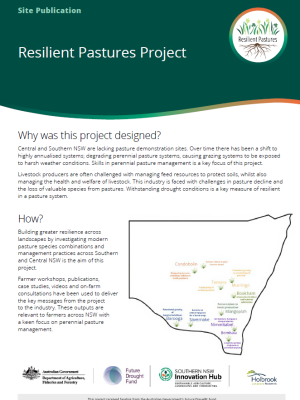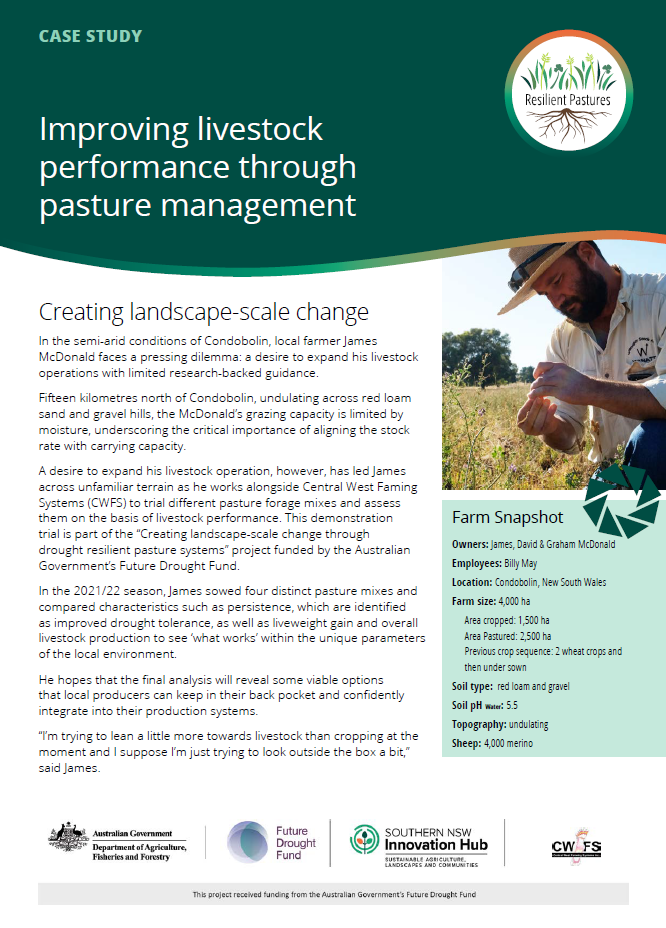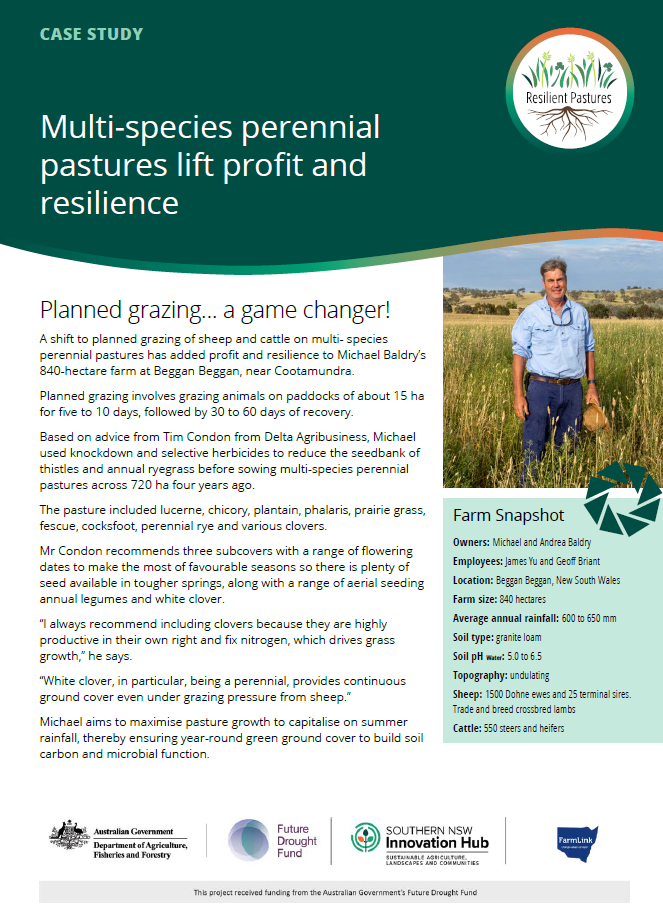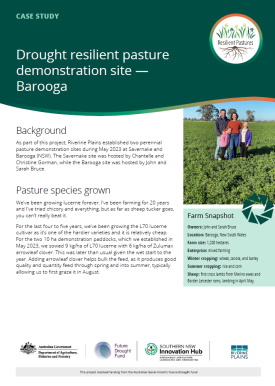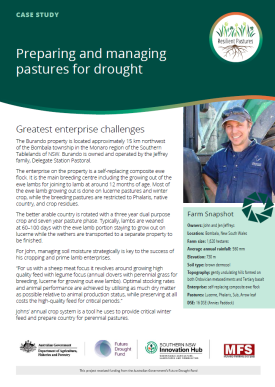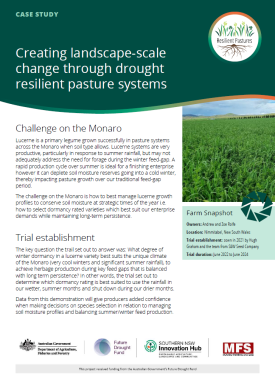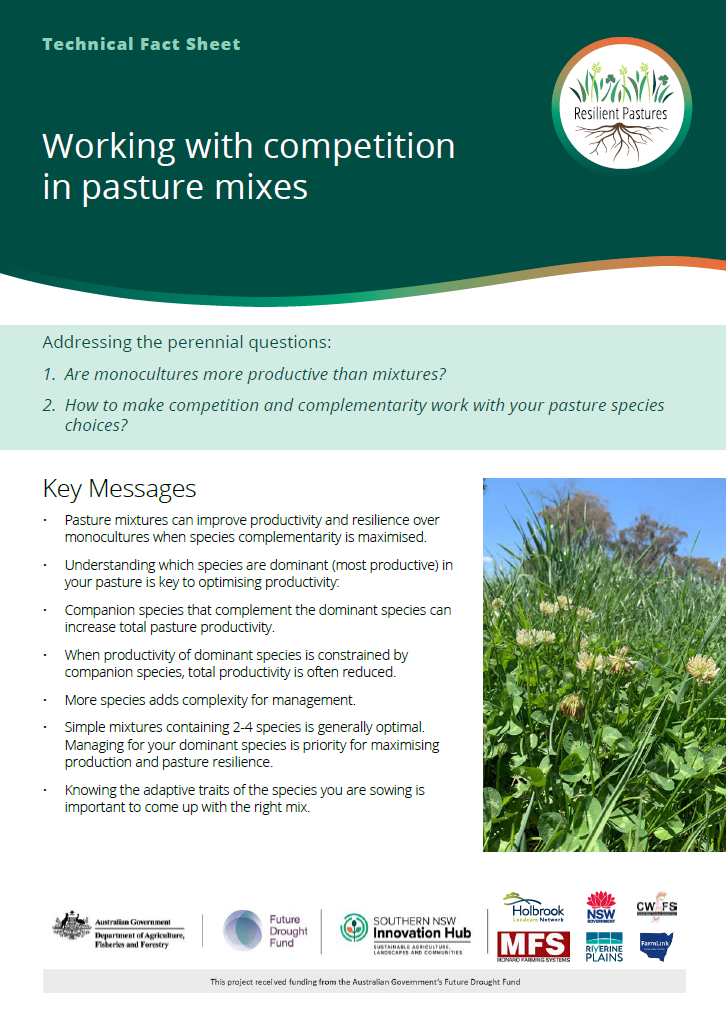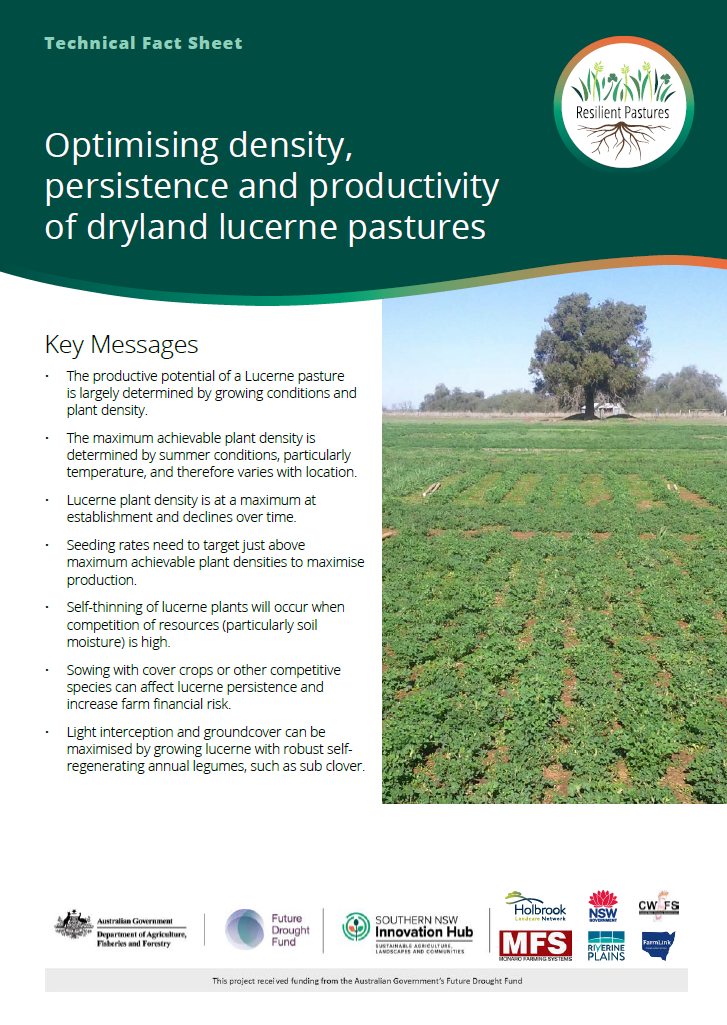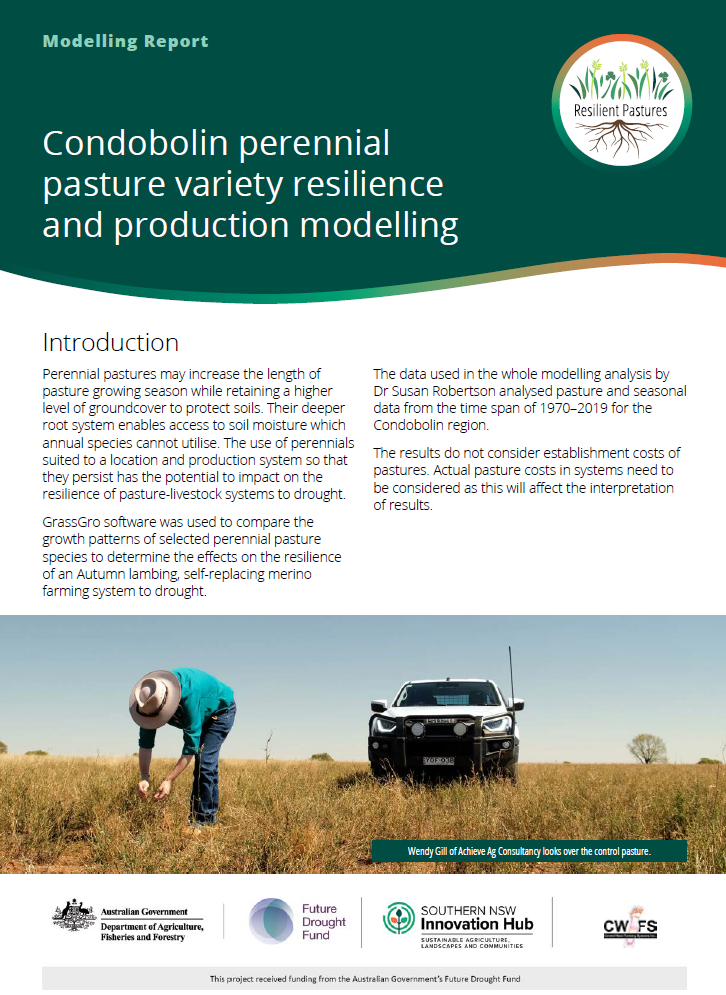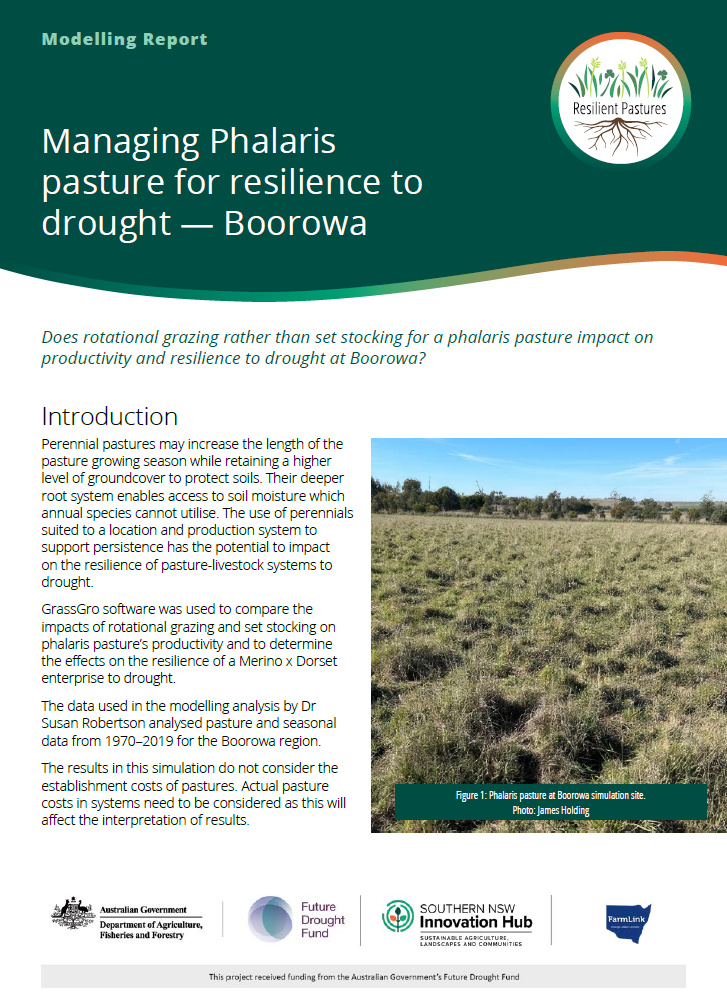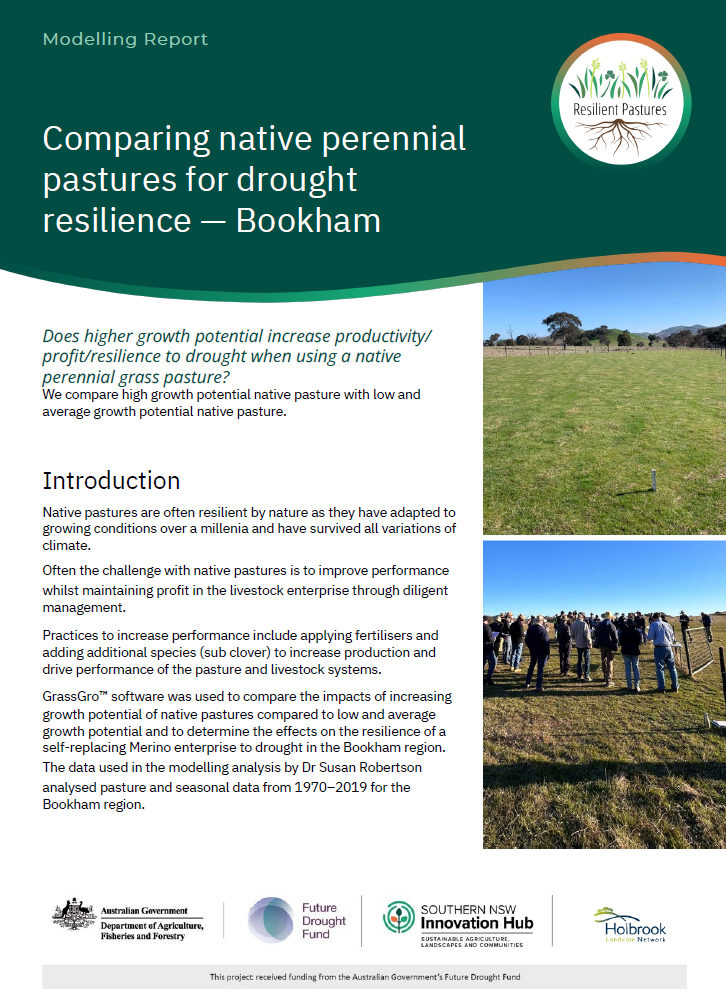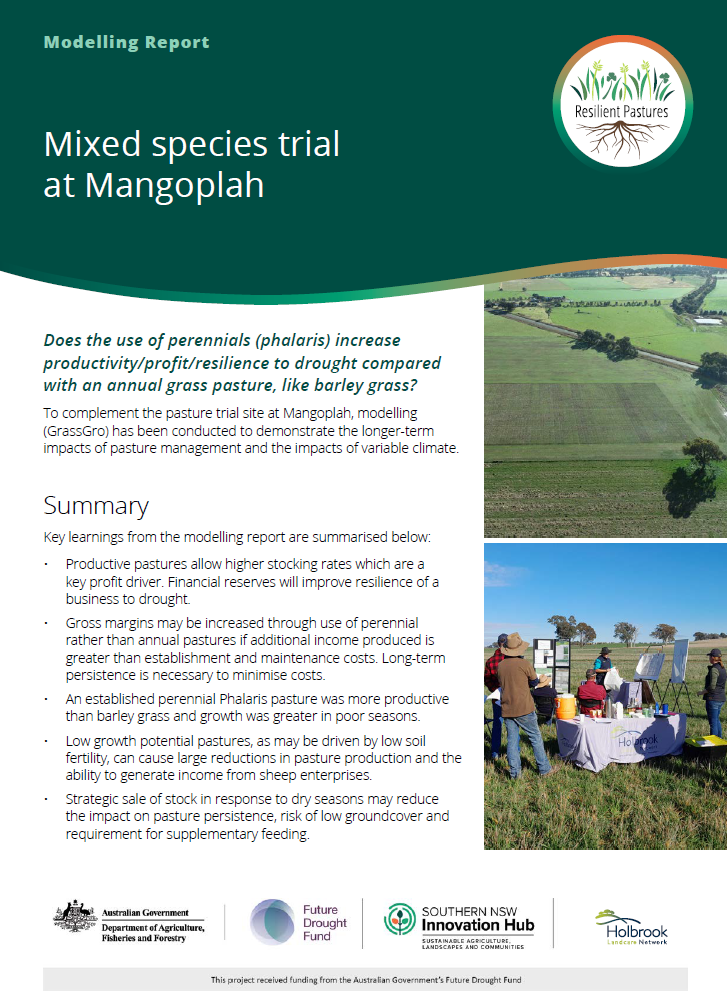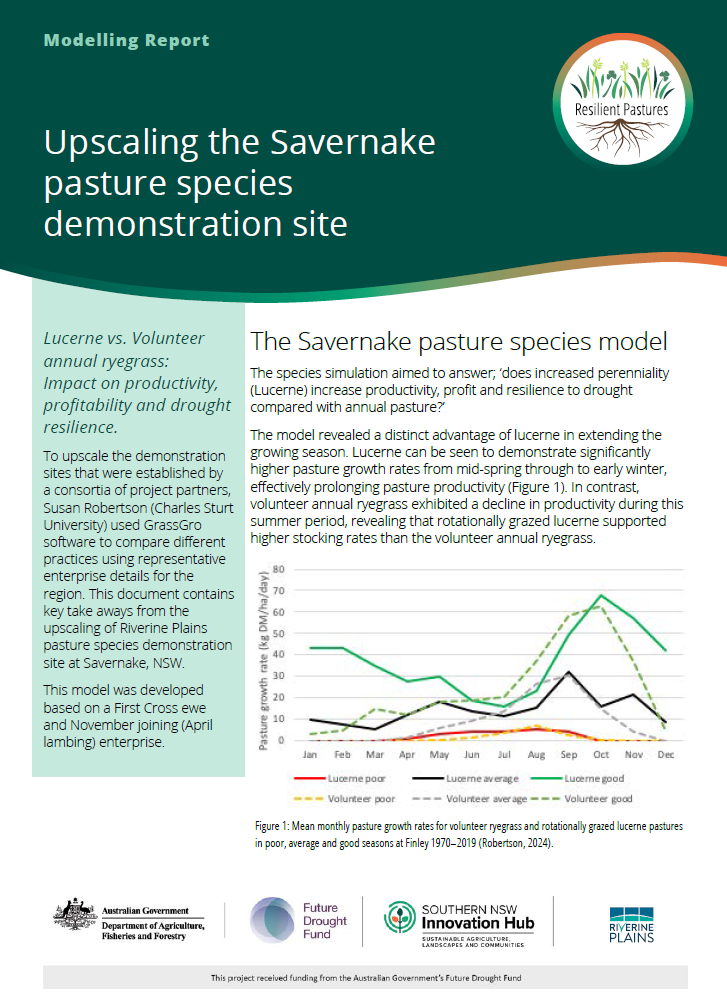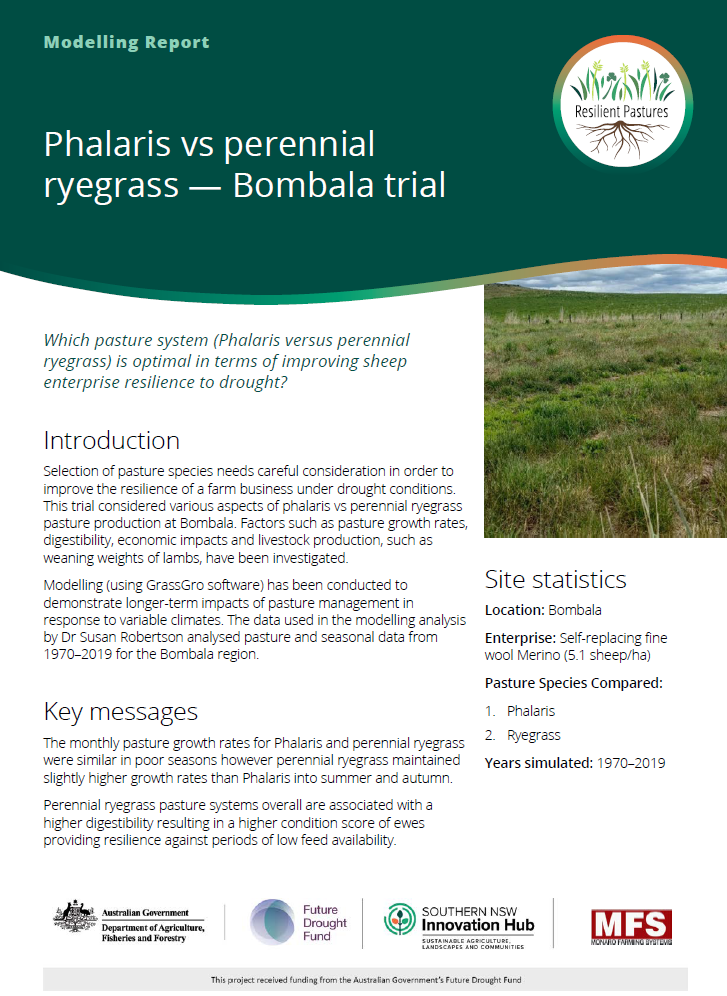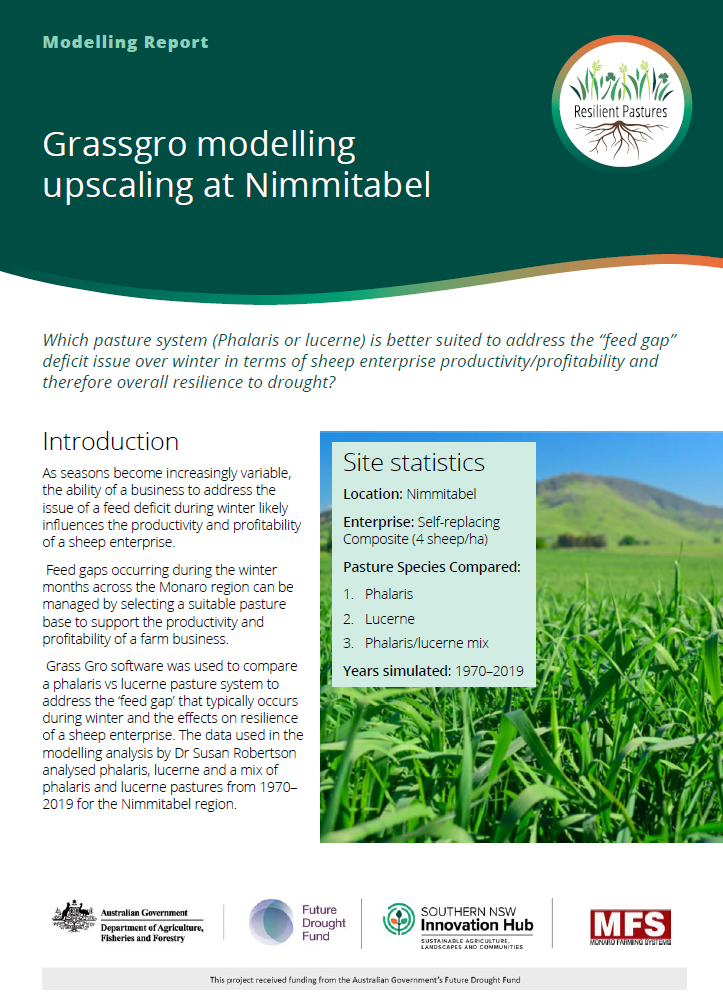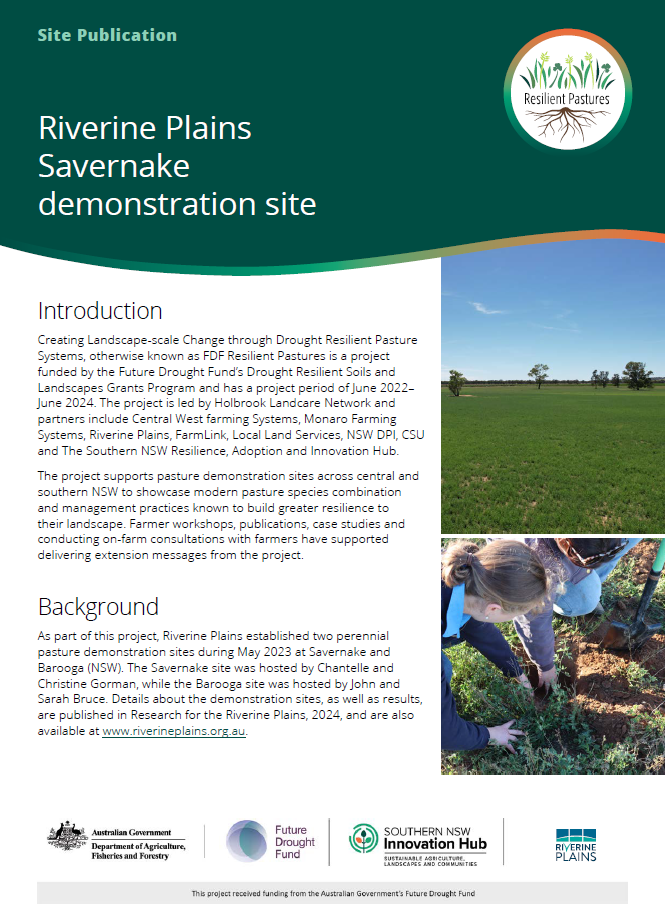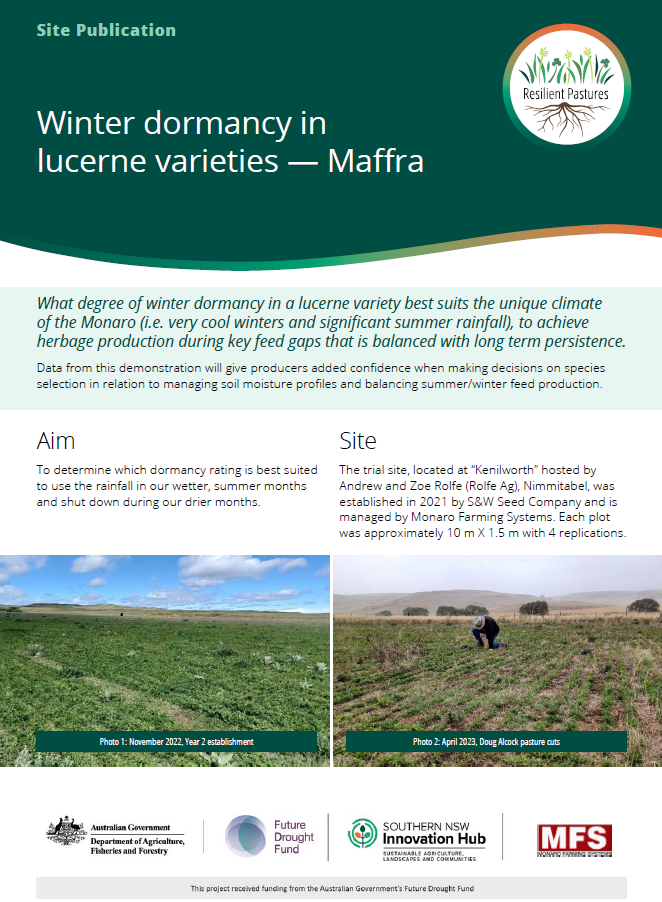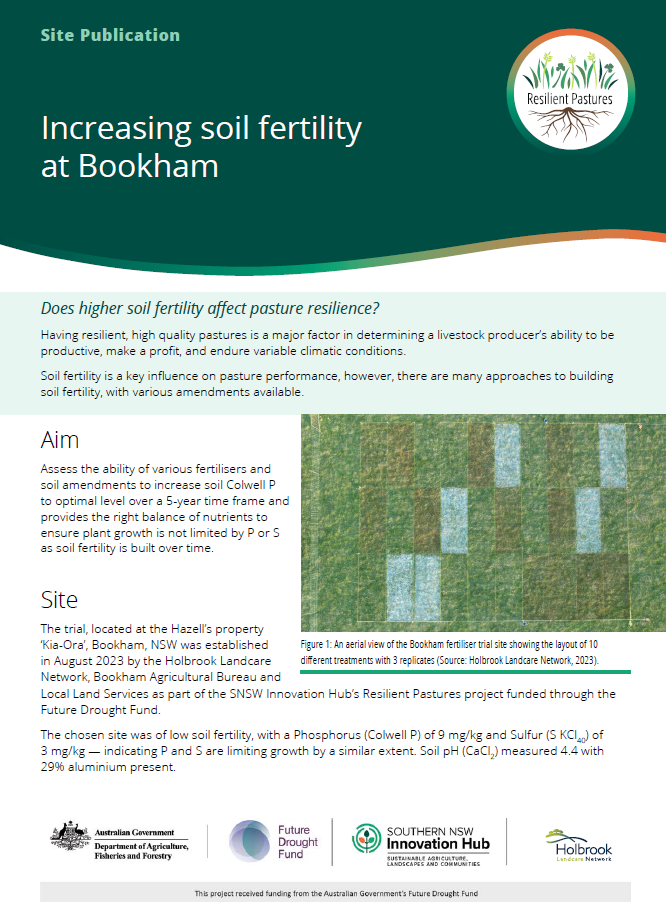
Creating Landscape-scale Change through Drought Resilient Pasture Systems, otherwise known as ‘FDF Resilient Pastures’ project was created to investigate modern species selection and management practices of perennial pastures across Central and Southern NSW. The project hosted sites on the Monaro, across the Riverina and into Western NSW.
The following resources provide information on various aspects of perennial pasture management, prepared by the ‘FDF Resilient Pastures’ project. Resources include information on pasture mixes, lucerne persistence, farmer experiences, scaled-out modelling of pasture management and location specific information for perennial pasture management in Southern NSW.
Developing and building skills in perennial pastures can enhance a landholders ability to build resilience in a farming business to mitigate drought conditions through improving pasture productivity, stocking rates and building landholder skills.
To visit Holbrook Landcare Network’s Resilient Pastures Project Page CLICK HERE.
Navigation Panel
Site Publication: Resilient Pastures Project
Central and Southern NSW are lacking pasture demonstration sites. Over time there has been a shift to highly annualised systems; degrading perennial pasture systems, causing grazing systems to be exposed to harsh weather conditions. Skills in perennial pasture management is a key focus of this project.
Livestock producers are often challenged with managing feed resources to protect soils, whilst also managing the health and welfare of livestock. This industry is faced with challenges in pasture decline and the loss of valuable species from pastures. Withstanding drought conditions is a key measure of resilient in a pasture system.
Case Studies
The case studies below have been developed by partners involved with the project. The case study topics have been designed to showcase successful practices identified amongst the project partners.
Central West Farming Systems: Condobolin Case Study
Case Study: Improving Livestock Through Pasture Management
In the semi-arid conditions of Condobolin, local farmer James McDonald faces a pressing dilemma: a desire to expand his livestock operations with limited research-backed guidance.
Fifteen kilometres north of Condobolin, undulating across red loam sand and gravel hills, the McDonald’s grazing capacity is limited by moisture, underscoring the critical importance of aligning the stock rate with carrying capacity.
Read more of Central West Farming Systems’ Condobolin Case Study here.
You can visit Central West Farming Systems Website here.
FarmLink: Beggan Beggan Case Study
Case Study: Multi-species Perennial Pastures Lift Profit and Resilience
Planned Grazing… a game changer!
A shift to planned grazing of sheep and cattle on multi- species perennial pastures has added profit and resilience to Michael Baldry’s 840-hectare farm at Beggan Beggan, near Cootamundra.
Planned grazing involves grazing animals on paddocks of about 15 ha for five to 10 days, followed by 30 to 60 days of recovery.
Based on advice from Tim Condon from Delta Agribusiness, Michael
used knockdown and selective herbicides to reduce the seedbank of
thistles and annual ryegrass before sowing multi-species perennial
pastures across 720 ha four years ago.
Read all of FarmLink’s Beggan Beggan Case Study here.
You can visit FarmLink’s Website here.
Holbrook Landcare Network: Rosewood Case Study
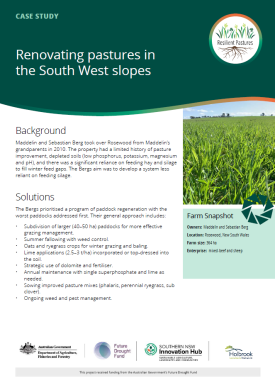
Case Study: Renovating Pastures in the South West Slopes
Maddelin and Sebastian Berg took over Rosewood from Maddelin’s grandparents in 2010. The property had a limited history of pasture improvement, depleted soils (low phosphorus, potassium, magnesium and pH), and there was a significant reliance on feeding hay and silage to fill winter feed gaps. The Bergs aim was to develop a system less reliant on feeding silage.
Read Holbrook Landcare Network’s Rosewood Case Study here.
Riverine Plains: Barooga Case Study
Case Study: Drought Resilient Pasture Demonstration Site – Barooga
As part of this project, Riverine Plains established two perennial pasture demonstration sites during May 2023 at Savernake and Barooga (NSW). The Barooga site was hosted by John and Sarah Bruce.
“We’ve been growing lucerne forever. I’ve been farming for 20 years and I’ve tried chicory and everything, but as far as sheep tucker goes, you can’t really beat it.“
Read Riverine Plains Barooga Case Study here.
Visit Riverine Plains Website here.
Riverine Plains: Savernake Case Study
Case Study: Drought Resilient Pasture Demonstration Site – Savernake
As part of this project, Riverine Plains established two perennial pasture demonstration sites during May 2023 at Savernake and Barooga (NSW). The Savernake site was hosted by Chantelle and Christine Gorman.
“In the last five years we have increased our pasture to around 30 percent between both properties, and could potentially increase this
further. However, you also have to work in with your crop rotations. So, if you
are pulling a paddock out of grain production to put pasture in, you have to balance how much grain you’re producing with the quantity of mouths (livestock) you have to feed.”
Read the Riverine Plains Savernake Case Study here.
Visit Riverine Plains Website here.
Monaro Farming Systems: Bombala Case Study
Case Study: Alternative Species Tiral in Bombala
Can alternative perennial pasture species match or out perform the persistence of traditional species in the Monaro region?
The ability of both legume and non-legume perennial pasture species to persist long-term and maintain a satisfactory level of productivity and feed quality in the Monaro region can be harshly impacted by the highly variable climatic and seasonal conditions present in the area.
Read Monaro Farming System’s Bomala Case Study here.
Visit Monaro Farming System’s Website here.
Monaro Farming Systems: Jefferys Case Study
Case Study: Preparing and Managing Pastures for Drought
Greatest Enterprise Challenges
The Burando property is located approximately 15 km northwest of the Bombala township in the Monaro region of the Southern Tablelands of NSW. Burando is owned and operated by the Jeffrey family, Delegate Station Pastoral.
The enterprise on the property is a self-replacing composite ewe flock. It is the main breeding centre including the growing out of the ewe lambs for joining to lamb at around 12 months of age. Most of the ewe lamb growing out is done on lucerne pastures and winter crop, while the breeding pastures are restricted to Phalaris, native country, and crop residues.
Read Monaro Farming System’s Jefferys Case Study here.
Case Study Video
Interested in hearing from Bombala producer John Jefferies? Check out this short video to see his journey trialing alternative species in his business.
Watch now: MFS_John Jeffreys_Case Study on Vimeo
Visit Monaro Farming System’s Website here.
Monaro Farming Systems: Nimmitabel Case Study
Case Study: Creating Landscape -Scale Change through Drought Resilient Pasture Systems
Challenge on the Monaro
Lucerne is a primary legume grown successfully in pasture systems across the Monaro when soil type allows. Lucerne systems are very productive, particularly in response to summer rainfall, but may not adequately address the need for forage during the winter feed-gap. A rapid production cycle over summer is ideal for a finishing enterprise however it can deplete soil moisture reserves going into a cold winter, thereby impacting pasture growth over our traditional feed-gap period.
Read Monaro Farming System’s Nimmitabel Case Study here.
Visit Monaro Farming System’s Website here.
Partner Videos
The FDF Resilient Pastures Project while lead by Holbrook Landcare Network has included partners from across the Southern NSW region. These videos showcase the exceptional work the Farming Systems Groups have put into this project. There is a focus on leading farmers utilising pasture management techniques to build drought resilience within their farming business.
In this video hear from producer James McDonald and Central West Farming Systems’ Wendy Gill on the key features of their resilient pastures demonstration at Condobolin
Join FarmLink Research in this video to learn more about the Resilient Pastures Demonstration Site located at the FarmLink Research Station at Temora.
Join Holbrook Landcare Network and the team at their recent Mangoplah demonstration site field day. Hear key messages about utilising perennial pastures and legumes, and nitrogen management.
Join Holbrook Landcare Network and the team at the Bookham Ag Bureau Resilient Pastures Trial Site. This site is exploring 9 fertiliser treatments and their efficiency in address low soil phosphorus levels in native perennial pastures.
Check out this video from Monaro Farming Systems as they explore the some of the alternative species used at their demonstration site and highlight the importance of selecting the right varieties and managing stressors in the system to increase persistence of pasture species.
Join Sophie Hanna (Riverine Plains), John Burce (Barooga Demo Site Host) and, Christine and Chantelle Gorman (Savernake Demo Site Hosts) as they take you through their on farm management of pasture species in their systems.
Tech Notes
These documents are designed to provide technical information to enhance skillsets in pasture management.
Pasture Modelling Publications
The following publications summarise demonstration sites and modelling results.
FINAL REPORT Resilient Landscapes : Simulation Modelling of Pasture Species and Practices for Drought Resilience.
A report preparded for Holbrook Landcare Network.
Prepared by Susan Robertson, Gulbali Institute, Charles Sturt University.
This study was commissioned by Holbrook Landcare Network as part of the ‘Creating landscape-scale change through drought resilient pasture systems’ project, funded by the Future Drought Fund via the Southern NSW Drought Resilience Adoption and Innovation Hub.
Choice of pasture species and their management impact on the profitability of livestock systems and the resilience of an enterprise to drought. The purpose of this study was to demonstrate the impact of choice of pasture species and management practices on resilience of pasture/sheep systems to drought, enabling producers to better prepare for future droughts.
Central West Farming Systems Modelling Report
Modelling Report: Condobolin Perennial Pasture Variety Resilience and Production Modelling
Perennial pastures may increase the length of pasture growing season while retaining a higher level of groundcover to protect soils. Their deeper root system enables access to soil moisture which annual species cannot utilise. The use of perennials suited to a location and production system so that they persist has the potential to impact on the resilience of pasture-livestock systems to drought.
GrassGro software was used to compare the growth patterns of selected perennial pasture species to determine the effects on the resilience of an Autumn lambing, self-replacing merino farming system to drought. [Read more]
FarmLink Research Modelling Reports
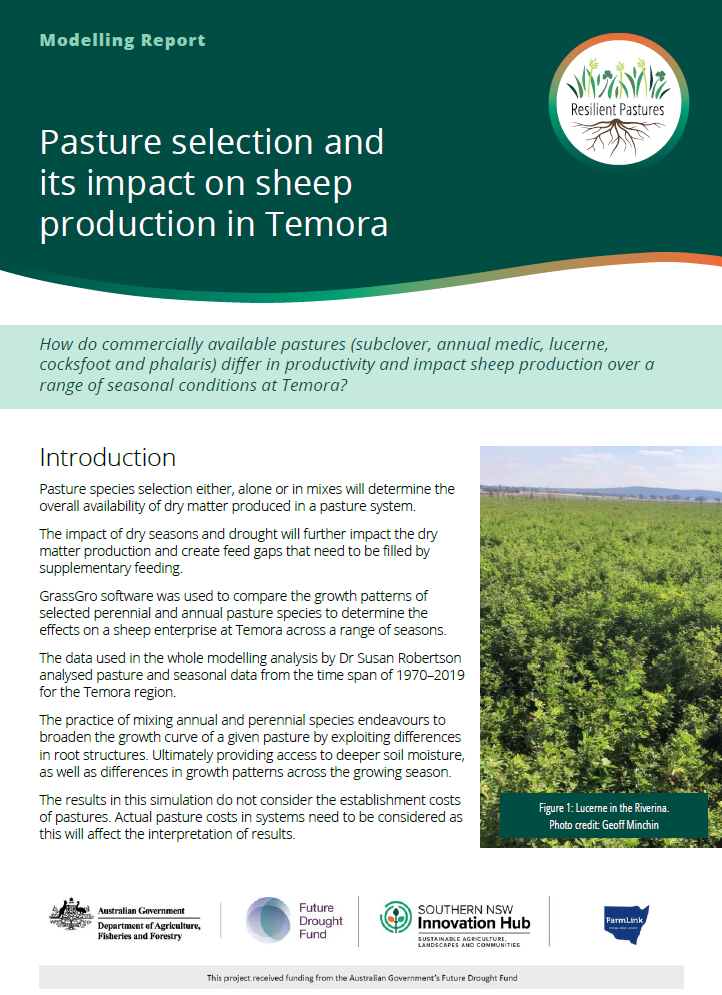
Modelling Report: Pasture Selection and Its Impact on Sheep Production in Temora
Pasture species selection either, alone or in mixes will determine the overall availability of dry matter produced in a pasture system.
The impact of dry seasons and drought will further impact the dry matter production and create feed gaps that need to be filled by supplementary feeding.
GrassGro software was used to compare the growth patterns of selected perennial and annual pasture species to determine the effects on a sheep enterprise at Temora across a range of seasons. [Read more]
Modelling Reporting: Managing Phalaris Pasture for Resilience to Drought – Boorowa
Does rotational grazing rather than set stocking for phalaris pasture impact on productivity and resilience to drought Boorowa?
Perennial pastures may increase the length of the pasture growing season while retaining a higher level of groundcover to protect soils. Their deeper root system enables access to soil moisture which annual species cannot utilise. The use of perennials suited to a location and production system to support persistence has the potential to impact on the resilience of pasture-livestock systems to drought.
GrassGro software was used to compare the impacts of rotational grazing and set stocking on phalaris pasture’s productivity and to determine the effects on the resilience of a Merino x Dorset enterprise to drought. [Read more]
Holbrook Landcare Network Modelling Reports
Modelling Report: Comparing Native Perennial Pastures for Drought Resilience – Bookham
Does higher growth potential increase productivity/profit/resilience to drought when using a native perennial grass pasture?
Native pastures are often resilient by nature as they have adapted to growing conditions over a millenia and have survived all variations of climate.
Often the challenge with native pastures is to improve performance whilst maintaining profit in the livestock enterprise through diligent management.
Practices to increase performance include applying fertilisers and adding additional species (sub clover) to increase production and drive performance of the pasture and livestock systems. [Read more]
Modelling Report: Mixed Species Trial at Mangoplah
Does the use of perennials (phalaris) increase productivity/profit/resilience to drought compared with an annual grass pasture, like barley grass?
To complement the pasture trial site at Mangoplah, modelling (GrassGro) has been conducted to demonstrate the longer-term impacts of pasture management and the impacts of variable climate. [Read more]
Riverine Plains Modelling Reports
Modelling Report: Upscaling the Barooga Drought Resilient Pastures Demonstration Site
Rotational grazing vs set stocking and April vs June lambing: enhancing pasture utilisation, livestock production and drought resilience.
The grazing simulation aimed to answer; ‘does rotational grazing, in comparison with set stocking, and November joining compared to January joining; increase pasture utilisation, sheep production and drought resilience?’
The model revealed that rotational grazing notably enhanced weaner growth rates during drought years for June lambing ewes when compared to the set stocked ewes.
There was a limitation in the models fixed six-week grazing period requirement for this simulation, causing results to show a lack of benefit for rotational grazing. Instead of a fixed period rotation, stock should be rotated based on a Food on Offer basis. [Read more]
Modelling Report: Upscaling the Savernake Pasture Species Demonstration Site
Lucerne vs. Volunteer annual ryegrass: Impact on productivity, profitability and drought resilience.
The species simulation aimed to answer; ‘does increased perenniality (Lucerne) increase productivity, profit and resilience to drought compared with annual pasture?’
The model revealed a distinct advantage of lucerne in extending the growing season. Lucerne can be seen to demonstrate significantly higher pasture growth rates from mid-spring through to early winter, effectively prolonging pasture productivity (Figure 1). In contrast, volunteer annual ryegrass exhibited a decline in productivity during this summer period, revealing that rotationally grazed lucerne supported higher stocking rates than the volunteer annual ryegrass. [Read more]
Monaro Farming Systems Modelling Reports
Modelling Report: Phalaris vs Perennial Ryegrass – Bombala Trial
Which pasture system (Phalaris versus perennial ryegrass) is optimal in terms of improving sheep enterprise resilience to drought?
Selection of pasture species needs careful consideration in order to improve the resilience of a farm business under drought conditions. This trial considered various aspects of phalaris vs perennial ryegrass pasture production at Bombala. Factors such as pasture growth rates, digestibility, economic impacts and livestock production, such as weaning weights of lambs, have been investigated.
Modelling (using GrassGro software) has been conducted to demonstrate longer-term impacts of pasture management in response to variable climates. [Read more]
Modelling Report: Grassgro Modelling Upscaling at Nimmitabel
Which pasture system (Phalaris or lucerne) is better suited to address the “feed gap” deficit issue over winter in terms of sheep enterprise productivity/profitability and therefore overall resilience to drought?
As seasons become increasingly variable, the ability of a business to address the issue of a feed deficit during winter likely influences the productivity and profitability of a sheep enterprise.
Feed gaps occurring during the winter months across the Monaro region can be managed by selecting a suitable pasture base to support the productivity and profitability of a farm business. [Read more]
Demonstration Site Publications
The Drought Resilient Pastures Project is made up of eight demonstration sites across the Southern NSW footprint.
If you would like to know more about Holbrook Landcare Network’s demonstration sites and keep up to day about our pasture and soil testing results check out our Project Page here.
Central West Farming Systems
Riverine Plains
Riverine Plains
Monaro Farming Systems
Monaro Farming Systems
Holbrook Landcare Network
Holbrook Landcare Network
FarmLink Research
Methods for Measuring Pasture Establishment with Dr. Richard Hayes
The below videos, featuring Richard Hayes from the NSW DPI, demonstrate methods for measuring pasture establishment and density in the paddock. They are designed to improve the skillset of pasture professionals.
Funding Acknowledgement
Creating Landscape-scale Change through Drought Resilient Pasture Systems, otherwise known as ‘FDF Resilient Pastures’ is a project funded by the Future Drought Fund’s Drought Resilient Soils and Landscapes Grants Program and has a project period of June 2022 – June 2024 through the Southern NSW Drought Resilience, Adoption and Innovation Hub. The project is led by Holbrook Landcare Network and partners include Central West Farming Systems, Monaro Farming Systems, Riverine Plains, FarmLink, Local Land Services, NSW DPIRD, and Charles Sturt University.


